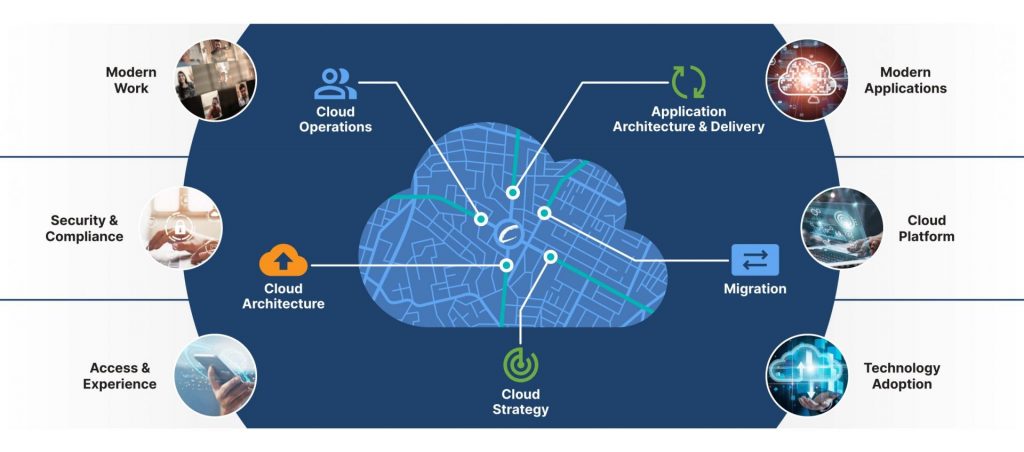The cloud is an amazing business enabler. It provides an infrastructure for applications and services without up-front costs, and a consumption model that allows spend to match usage more closely than with on-premises models. With proven methodologies for new deployments, migrations and hybrid models, cloud adoption continues to grow rapidly. Well architected cloud solutions lead to business outcomes like cost reduction, enhanced operational agility, and the ability to scale up or down with the requirements of the business. To achieve these outcomes, solutions must holistically account for technology delivery. This requires a broad view across security, compliance, access, experience, modern work, and modern applications. This view must also account for integration with operational tools, data, software dependencies, and organizational expertise.
When these factors are not properly addressed, cloud decisions begin to dictate business decisions. Some examples of this are:
- The cloud storage provider becomes the de-facto workload provider due to data access costs.
- Better fitting services from other providers are ignored due to integration or operational complexity.
- On-premises applications are managed and operated separately from cloud applications.
- Redundant tooling is required for cloud and non-cloud workloads.
The wide adoption and maturity of cloud provides benefits in the form of recommended practices to simplify cloud architectural decisions. The major challenges have already been exposed in the form of lessons learned from sub-optimal outcomes. Expertise exists which can be leveraged to assist in the process from planning and design to deployment and operations. The starting point is understanding the goals your business is looking to achieve and using them to define your use cases for cloud. Business use cases are the natural starting point for any transformation project. Cloud adoption is no exception. Begin with a definition of the outcomes you are trying to achieve. Is the goal to reduce cost, increase operational agility, minimize capital expenditure (CapEx), etc.? These outcome goals can then be further defined into corresponding use cases. For example, operational agility may break down into several use cases including ‘single-click provisioning of standardized development environments’ or similar.

Working from the business outcomes down to use cases provides a roadmap of features/capabilities you intend to implement. It also creates the success criteria for the project. This process helps ensure that your organization does not end up with a completed project mixing key components. It also ensures that your organization knows what the finish line looks like. The next step is to define business priorities for technology delivery. What is important to your organization? Things like service portability, lock-in avoidance, cost control, etc. should be defined and prioritized. By defining these you will be better equipped to make architectural decisions based on available options. The priorities will provide criteria for decision making when compromise is required. An example of this is service portability. In general, the more portable an application or service is, the more complex and costly it is. These trade-offs are easiest to navigate with clearly defined priorities.

The definition of the business objectives and use cases will narrow the focus of technology selection. Various products and solutions will naturally be eliminated based on those definitions. This leaves a smaller workload for assessment, and a more clearly defined criteria set from which to assess options. These definitions can also narrow down the focus of broad architectures. For instance, prioritizing low-complexity while deprioritizing lock-in avoidance and portability will often steer architectures towards single vendor solutions as opposed to multi-cloud options. Your existing architecture is the next consideration. Which applications, services and tools will require integration with cloud services? Which applications and datasets will create dependencies for cloud workloads? If the cloud will be primarily used for net new application development the dependencies will be limited, but two separate operational models will emerge. If an integrated operational model is desired, then your existing application and operational stack will further narrow the technology options to choose from.
To differentiate in a highly competitive space, top-tier providers create offerings tailored to specific markets. Beginning with a baseline of the workloads you use, the way your team develops or uses software, and the operational tools currently in use will help to select a provider that fits your defined objectives and use cases.
Some providers are geared well towards rapid development of new applications, others are geared toward migration of existing workloads and the ability to bridge the gap between on-premises and cloud. The latter of these often provide common tooling for operations, identity, security, and application development. The former may be the right fit for a company developing new software, while the latter may be a better fit for an established enterprise modernizing technology delivery.
At CompuNet our team has heavily invested in expertise around cloud platforms, modern applications, and modern work. This expertise is built upon our proven capabilities in data center infrastructure, security and compliance, access, and experience. Bringing this technology expertise together with deep industry specific knowledge allows us to help align your cloud decision to your business without gaps.
By partnering with your technology stakeholders and aligning to the goals of your business, CompuNet’s cloud architects work with our domain experts to provide technology options that drive the outcomes you need. With a broad suite of technology partners, and an eye on the future of technology grounded in what works today, our team works to make any cloud transition a smooth one.
Whether your cloud journey is well under way, or just over the horizon, our team is here to help. With a large catalogue of cloud workshops and consultations typically delivered at no cost to you, CompuNet’s team is ready to engage with you to build cloud enabled outcomes.






